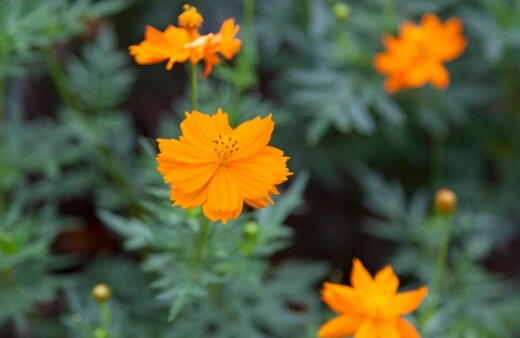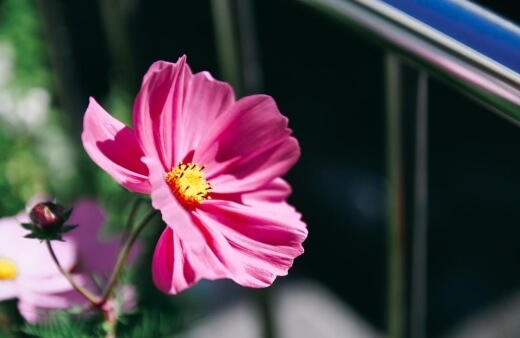Cosmos flowers are a real treat for the eyes – each variety has its own brilliant palette, from pastels to deep shades. The flowers are whimsical as they seem to dance in the wind.
In our ultimate guide about cosmos flowers, we’ll go through how to grow and care for these beauties, propagation advice for cuttings and seed, and also sharing what to look out for in terms of pests and diseases.
More...
Family: | Asteraceae |
|---|---|
Genus: | Cosmos |
Common Names: | Cosmos, Mexican aster, Cut-leaf cosmos |
Plant type: | Annual |
Size: | Up to 1.8 m tall and 90cm wide |
Sun: | Full |
Soil type: | Well-draining |
Soil pH: | Acidic, 6.0–6.8 |
Flowering time: | Summer to autumn |
Flower colours: | Golden yellow, white, pink, magenta, orange, yellow, red, chocolate |
Native to: | Northern South America, Central America, and southern North America |
Introducing Cosmos Flowers

There are over 25 species of Cosmos or Mexican aster as it’s more commonly known. Cosmos is part of the Asteraceae family of plants. Cosmos reseeds itself and can handle dry and fertile soils. It’s a hardy plant and has very few needs.
Cosmos plants are Mexican natives that are easy to grow and love bright, sunny areas. The flowers are colourful and look very similar to daisies.
They’re in flower throughout summer, and attract some beautiful visitors in the form of birds, bees, and butterflies. The good news is that cosmos flowers grow easily from seeds and they can even handle poor soil conditions.
Cosmos produce daisy-like flowers in shades of pink, orange, red and yellow, white, and maroon. The flowers can be bowl or cup shaped and can reach a height of almost 2 metres.
Cosmos flowers can grow in the garden and pots and also look amazing in a vase as freshly cut jewels. Cosmos take approximately 12 weeks to flower, and bees love them!
These flowers can grow anywhere between 45 cm to 1.5 metres tall, depending on the variety so just be sure to plan their growing and living space accordingly.
Varieties of Cosmos flowers
There are more than 25 species of cosmos but three species are most commonly used in gardens and landscaping.
Sulfur Cosmos (Cosmos sulphureus)

Cosmos sulphureus is native to Mexico, Central America, and northern South America. It has golden yellow flowers, is very drought tolerant and loves hot weather.
The plant can grow to a height of 1.8 metres and produces double and semi-double flowers. Some of the more recent cultivars of cosmos flowers are shorter, with more orange shades and smaller flowers.
Garden Cosmos (Cosmos bipinnatus)

Cosmos bipinnatus produces colourful daisy-like flowers in white, pinks, reds, and orange. They reach a maximum height of 1.2 metres so they are shorter than C. sulphureus and have many popular hybrids.
They aren’t as heat tolerant as C. sulphureus but C. bipinnatus will grow well in any sunny space.
Chocolate cosmos (Cosmos atrosanguineus)

Cosmos atrosanguineus is also known by the common name Chocolate cosmos. They are a perennial plant, although often grown as an annual. It has ferny, dark green leaves.


Get Your Free Guide:
Master Growing Australian Natives eBook
A Must Have Complete Guide for Every Australian Garden
Get Your Free Guide:
Master Growing Australian Natives eBook
A Must Have Complete Guide for Every Australian Garden
Cosmos atrosanguineus gets its name from the colour of the flower and its scent. The Chocolate cosmos has dark-maroon or deep red, velvety flowers which bloom from midsummer to autumn. The flowers give off a dark chocolate fragrance, especially on dry, hot, sunny days. They grow to a height of around 75cm.
Other popular cosmos flower cultivars include:
- Cosmos ‘Bright Lights Mix’: This variety has a blend of brilliant yellows, oranges, and reds.
- Cosmos ‘Cosmic Orange’: This semi-double orange flower has great drought tolerance.
- Cosmos ‘Peppermint Candy’: The petals are magenta and white.
- Cosmos ‘Sea Shells’: A lovely mix of pastel colours with tubular petals.
- Cosmos ‘Ladybird’: This cosmos is a shorter variety with flowers in red, yellow, orange, and gold, and is 45 to 60cm in height.
- Cosmos ‘Picotee’: Pretty white flowers with a crimson border or flecks.
- Cosmos ‘Purity’: A beautiful and classic white flower.
If you feel inspired to grow other flowering plants in your garden, use our flowering plants category to learn more about what would best suit your needs and your garden.
How to Grow Cosmos Flowers in Australia

Cosmos flowers don’t need any fancy soil prep. They are quite happy with a soil that is not too rich, otherwise you’ll end up with great leaves but less than great flowers.
The soil you use should be well-draining and cosmos are tolerant of most soil pH levels. For best growth, go for neutral to alkaline soil. Cosmos will handle warm, dry weather well and are even drought-tolerant.
You want to sow the seeds lightly, not more than 3.5 cm. If you are growing cosmos flowers from seeds, it can take about 7 weeks for the first flower. If you leave the spiky-brown seed heads to just blow away during autumn, cosmos will probably self-sow in your garden.
Best Soil for Cosmos Flowers
Cosmos flowers will grow in a wide range of soils. It does best in moderately fertile, well-drained soil. Crumbly soil texture is ideal with neutral to alkaline pH levels. Cosmos may struggle in clay soils.
The soil shouldn’t be too rich. Rich soil will result in a lot of soft foliage growth, at the expense of flowers. It is worth mulching over the soil where Cosmos is planted, to help keep the roots cool and moist.
If you’re worried about your cosmos drooping, you can stake the plant or grow it close to other plants that can support it. Caring for your soil is a make or break for gardening success.
Have a read through our soil care gardening tips and articles to make sure you get the recipe just right.
Where to Position Your Cosmos in Your Garden
They can be grown in a sheltered garden bed or do equally well in a container pot. It is best to plant cosmos of both species in full sun. While they do best in a sunny spot, they will tolerate dappled shade.
Given their height and delicate stems, they should be positioned in a part of your garden which is sheltered from strong winds. Planting these with companion plants is a good idea as they’ll provide some protection. Also, avoid any parts of your garden that are prone to waterlogging.
If planting cosmos flowers in the garden, consider their height against other plants. Cosmos are relatively tall flowers, so are typically placed behind some shorter plants in the front of a garden bed.
Similarly, if you are planting them in a container pot, consider the range of heights of the potted colour. Lower-growing plants with taller cosmos flowers behind make a fantastic display. They look equally good when mass planted in containers by themselves.
How to Propagate Cosmos Flowers

Cosmos Flowers Propagation from Cuttings
You need sterile shears or scissors and a pot of sterile, well-draining potting soil. Fill a small 7cm container with moist potting soil and make a shallow hole.
Aim to find a cosmos shoot that has 3 to 5 leaf nodes on the stem and then cut under the last leaf node. You’ll then carefully cut off the leaves at this last leaf node, leaving the node in place for more growth.
Place the cut tip of the stem in the hole, making sure that the last leaf node is above the soil line. Push down the soil around the stem, making it compact enough to keep the stem upright and in place.
Water well and keep the soil moist. You should see new leaf growth in about three weeks. Once you see the new leaf growth, you can gently pull the root ball out of the pot and transplant the root ball to its new spot.
Propagating Cosmos Flowers from Seed
Cosmos can be propagated from seed. The best time to sow cosmos seeds depends on where you are based in Australia.
In tropical areas sow seeds from May through October. In temperate parts of Australia, you can sow seeds from July to late December. Sowing cosmos seeds in cold Australian climates should take place from September through to mid-summer.
You can sow cosmos seeds as late as January in temperate and colder regions of Australia and they will still flower before colder weather hits.
It is easiest to raise the seeds in seed beds or punnets, but you can sow seeds directly into your garden if you’d prefer. You will note that the seeds are big, so sow only a few seeds in clumps about 45 cm apart to a depth of approximately 6 mm.
Seedlings should emerge in two to three weeks. Thin out the strongest growths to one or two seedlings. When transplanting the seedlings into the garden they should be placed a similar distance apart.
Caring for Cosmos Flowers

Fertilising Cosmos Flowers
Cosmos are quite self-sufficient in terms of nutrients and feeding this plant should be a case of less is more. Giving it too much nitrogen will slow down flower production. This is because nitrogen encourages strong greens and discourages flower production.
Most of your balanced fertiliser blends usually contain too much nitrogen for flowering annuals. Many gardeners get trapped in a frustrating cycle. They don’t see any flowers, so they fertilise their plants.
The more fertiliser they add, the fewer flowers appear. If you do find that your cosmos flowers are not blooming, you can add a phosphorus fertiliser like bone meal. When the soil has recovered from the excess nitrogen, your cosmos will be covered in plenty of flowers once again.
When do cosmos flowers need fertiliser?
Whether you plant your seeds indoors or outdoors, cosmos flowers can use a small amount of fertiliser when they are planted. Choose a fertiliser made for blooming plants, which will have a low nitrogen count.
Mix the minimum amount into the soil when planting cosmos flowers seeds and then you can forget about feeding them for the rest of the season. Fertiliser for cosmos planted in pots is a little more important.
There is a small amount of soil available for their roots to feed from and so they will need to be fed a bit more frequently. You can sprinkle a half teaspoon of blooming plant fertiliser on the soil around each plant and water it into the soil.
Repeat this process once every three to four weeks until the end of the flowering season. If you notice your cosmos starting to slow down in terms of producing flowers, you can cut back on the fertiliser for a few weeks and then adjust your feeding as necessary.
Cosmos Watering Schedule
Once your cosmos is established, you don’t need to water your plant unless there is a long drought. These are the last plants that need water if there is a water shortage crisis.

Deadheading and Pruning Cosmos Flowers
Pinching back and deadheading your cosmos flowers are two different things but your plant needs both. The main reason to pinch back is to promote new growth as it stimulates growth and a more bushy shape.
Pinching
Pinching is a type of pruning and basically means picking off new growth on a plant. You can use your fingers or shears depending on the stems. For a tougher stem, shears will help get a better cut that minimises infection or disease.
You’re aiming to pinch off a stem just under a pair of leaves. This is where you find two nodes and when you remove the top part of the stem, two new ones will grow from those nodes. Pinching back can also stimulate flower production.
You can start cutting back your cosmos flowers early in the growing season and keep doing this regularly.
Deadheading
Deadheading gives you more flowers throughout the season and this, much like the name suggests, means removing dead flowers. When you see your cosmos flowers start to fade, pinch or cut them back.
The life cycle of a flowering plant ends in setting seeds. When you remove the dead flowers, you trick the plant into creating more flowers so it can get back to seed setting.
When you see a fading cosmos flower, you can cut it back down to the next bud. If there are no buds, you can cut it back to the next set of leaves and for bare stems, cut it back all the way to the base of the plant.
It’s a good idea to start pinching and deadheading cosmos flowers early but if you wait too long, all is not lost. You can trim back the entire plant by about one-third when most of the flowers have begun fading.
Pests and Diseases of Cosmos Flowers
Cosmos flowers are not demanding. They are actually quite hardy but there are a few diseases that might cause issues - fungal, bacterial and insect viruses.

If you manage to control insects, offer the right water levels, and plant healthy plants you can hopefully minimise the problems. If your cosmos flowers are dying during the growing season, it could be one of the diseases below.
Two of the most common fungal diseases are Fusarium wilt and powdery mildew.
Fusarium wilt
Fusarium wilt causes the plant to wilt and discolours the stems and leaves. If you dig up the plant, you will notice a pink mass on the roots. The whole plant will unfortunately die and needs to be destroyed so the fungus doesn’t spread.
Powdery mildew
Powdery mildew spores float on the wind and attach to any host plant in shade. The fungus forms a powdery white coating over leaves, causing the foliage to become yellow and drop off if it’s not treated.
Make sure your cosmos has good ventilation, bright light, and is watered during the day so the foliage can dry. You can also use a horticultural fungicide.
Bacterial wilt
Bacterial wilt is one of the classic cosmos flower diseases and causes stems to wilt at the base. The entire stem and flower becomes infected and eventually the root system too. You’ll need to dig up and destroy the plant unfortunately.
Aster yellows
Aster yellows is another disease that affects any plant in the Aster family. It is transmitted by leafhoppers and is caused by phytoplasma. You will notice the cosmos flowers dying after becoming distorted and stunted. The foliage will be mottled and yellow. Infected plants will once again need to be destroyed.
Cosmos plants are a garden buffet for certain insect pests. They don’t do much damage but some of them transmit viruses and disease when they feed.
Thrips
Thrips transmit tomato spotted virus which has no cure. The flower buds are delayed and distorted and when they do open you’ll notice spotted, ringed, or lined petals.
Other sucking insects can affect the plant’s health. You can use a good horticultural soap and quick blasts of water during the day to remove many of the pests.
Cosmos Flowers FAQs

Do cosmos come back every year?
Apart from a few tender perennial varieties (Cosmos atrosanguineus), cosmos will not come back every year. Cosmos is an annual plant that will self-seed in most soils though, so if you’re lucky, your old plants might replace themselves by seed next spring.
Where do cosmos flowers grow best?
Cosmos grow best in sunny spots with fertile soil. If you have access to rotted manure or plenty of organic compost, mix it through the bed, or planting medium in your pots to give cosmos flowers the best start in life.
Choose a really good sunny spot with shelter from high winds.
What month does cosmos flower in Australia?
Cosmos usually begin to bloom in early summer (mid-December in most of Australia) and can continue flowering until late autumn and even early winter with regular deadheading and good weather.
Some varieties, like chocolate cosmos, which comes back most years in Australia, have a head start and may flower earlier, in November.
Will cosmos grow in pots?
Not only will cosmos grow in pots, but they will thrive. The improved drainage and more nutritious compost we typically fill our pots and containers with is a great planting situation for cosmos.
And to top it off, cosmos look stunning in pots, particularly taller varieties, which have a powerful impact in the garden and will be buzzing with bees all summer long.
Can you leave cosmos in the ground?
Cosmos rarely suffer from any lasting root rot, so there is no harm in leaving spent flowers in the ground when they finish flowering. As annual plants, they will not re-flower, but the dry seed heads, stems and leaves provide shelter for wildlife through winter.
If you prefer a tidier garden, simply shake the seed heads around the area to encourage regrowth, and then compost the rest of this year’s top growth.
How do you keep cosmos flowering all summer?
Cosmos are a brilliant choice for an annual flower display, cut flower gardens, or just ornamental pots and borders. With a weekly round of deadheading you can keep your cosmos flowers blooming all summer long.
Note though, that cosmos do not need deadheading, but it will improve their flowering span.
How long do cosmos blooms last?
Each cosmos flower will last on the flower for about 5-7 days, depending on the heat and the moisture available in the soil. Blooms dropping before then may be an indication of overwatering or under watering.
In vases, cosmos blooms tend to last for under a week, but adding a drop of bleach or vinegar to your vase water can extend that by a day or two.
Can I just scatter cosmos seeds?
While the best way to grow seedlings for the garden is in pots, which gives them more space, and less competition in their early stages, you can just scatter cosmos seeds directly on the ground in autumn or spring.
How do you make cosmos bushy?
Pinching out cosmos seedlings is an important part of their care, and every time you deadhead them, you can repeat the process, adding to the bushy, frothy effect of the frondy foliage.
To make your cosmos bushy, simply pinch out your seedlings (with clean hands or scissors) just above the lowest true leaves. After about a week, repeat the process on the two new stems. That way you’ll have slightly shorter, but bushier, sturdier plants.
What time of year do you plant cosmos?
Cosmos are generally planted in spring, but can be planted in autumn to mimic their natural cycle. Spring planting is the better option though, as there is no risk of frost damage and cosmos hardiness varies greatly between each cultivar.
How tall do cosmos get?
Cosmos can grow up to 1.5 metres tall if you choose the right variety, but most cosmos species grow somewhere between 30-60cm tall. Pinching out cosmos will limit their height too, so if you want height, but still need a bushy effect through summer, deeply enrich your soil, and sow cosmos about 10cm apart.
Do I soak cosmos seeds before planting?
There is no need to soak cosmos seeds before planting, but they do appreciate well-watered soil to grow into. Prepare your seed bed or pots by filling them with a decent seed compost; then water the soil from the base until the surface is moist (stand pots in a tray of water).
Then carefully sow a few seeds in each pot, or 10-15 cm apart in the ground, and lightly water to improve contact.
How fast do cosmos flowers grow?
Cosmos usually take between 7 to 21 days to germinate and will flower within 50 to 60 days of germination.
How do you harvest cosmos flowers?
If you want to harvest more seeds, you need to leave a few flowers on the plant because they will self-seed. You can cut the flowers off any time after blooming, but it's best when the petals have opened.
If you cut the flowers when they first open, they should last more than a week in water.
Jazz Up Your Garden by Growing Beautiful Cosmos Flowers
If your garden is in need of a bit of brightness and colour, cosmos flowers will jazz it up for sure. You have so many varieties to choose from, whatever shade inspires you most. They are drought tolerant and not too fussy in general.
Once established, you can even forget to water them for a while. They can self-seed and when you remove their dead flowers, they just produce more beautiful ones.
We think cosmos flowers are simply charming and we’re giving them our green thumbs up.

Published on January 12, 2023 by Maisie Blevins
Last Updated on February 22, 2025




